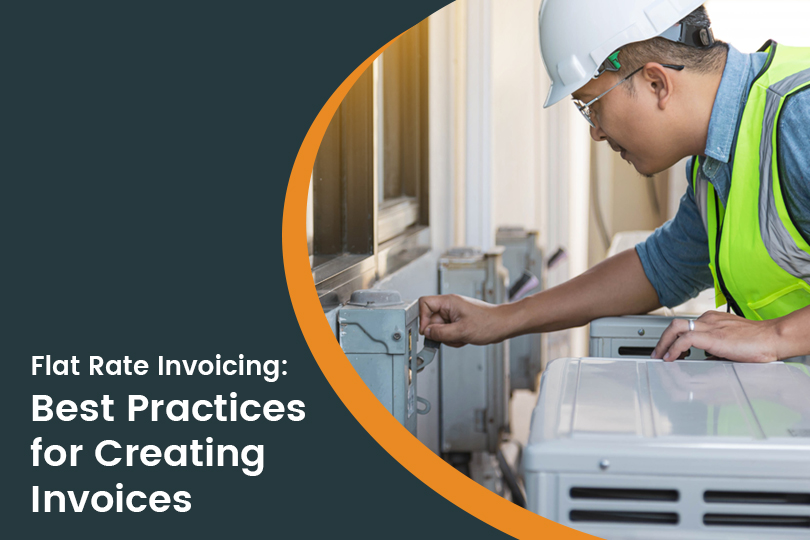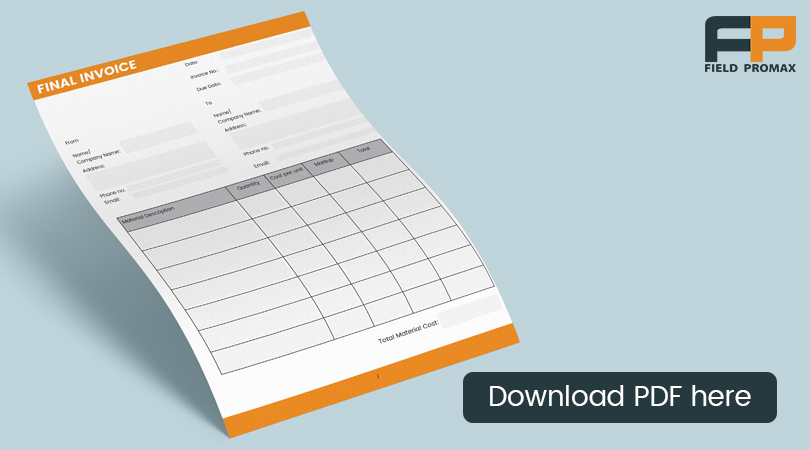An Insight on How to Complete the HVAC Invoice and Other Essential Tips

We all know invoicing is important. That much is true across every business and every industry. But invoicing best practices aren’t universal. Sure, the tried and true fundamentals are sound—be clear, be detailed, be professional—but the real secret sauce of a great invoicing process is industry-specific. Running a profitable HVAC business requires carefully billing customers for the services, repairs, and equipment your heating and air conditioning company provides. HVAC invoices fuel your company’s operations, often making the difference between net profit growth and scrambling to meet payroll each month. To this end, in particular, mastering HVAC invoicing and HVAC flat-rate pricing becomes extremely important.
Grow your HVAC Business with Field Promax HVAC Field Service Software. Sign up for Free Trial now!
HVAC contractors have a unique set of challenges to address with their invoicing, as well as a unique set of opportunities to seize. In the HVAC world, the function of a service invoice goes well beyond that of a simple receipt. A company can expect the cash flow to suffer in the absence of a good HVAC invoicing strategy. It will not only make you look unprofessional to a client, but it will also trap you in the hassle of paper and pen.
If you are wondering how you can resolve this issue and structure the invoices, you need some relevant information for developing an organized and productive HVAC business. So read ahead, we are taking a deep dive into the best invoicing practices in the HVAC industry. In this guide, we’ll explore the intricacies of completing HVAC invoices and share essential tips for success. Additionally, we’ll delve into the concept of HVAC flat-rate pricing, highlighting the advantages and disadvantages of not utilizing it. Follow them and see your company take the leap to the next level.
Table of Contents
Significance of Invoice in HVAC Business
The invoice is a document that reflects the amount owed after service. It contains full details of the service so that you can hand it over to the client after completion of the service. After receiving an invoice, the client makes a payment and offers a receipt as proof of payment received.
An invoice is a record of the services offered and the amount the client owes to you. It is sent after you complete the installation, repair, or maintenance job for a cooling/ heating unit. Based on the payment cycle agreed upon, the invoice can be raised monthly, semi-annually, or annually. An invoice should have details of the services offered equipment used, time spent on labor, system information, client details, business information, and service date.
There are several benefits of proper invoicing if you want to run a successful HVAC business. However, it primarily helps you achieve the following goals:
- Invoices work as a claim for payment for the services or goods offered.
- Invoices help significantly in keeping the team, office, and accounts organized.
- Invoice is also helpful in getting payments on times that too right amount.
- An invoice will also help in enhancing your efficiency.
Learn how to use the latest technology for the best invoicing practices. Book a FREE DEMO with us.

How to Create A Perfect HVAC Invoice
Accurate and timely invoicing is crucial for the success of any HVAC business. It not only ensures that you get paid for your services but also helps build trust with clients. Here’s a step-by-step guide to completing HVAC invoices effectively.
A. Client Information
- Start by collecting comprehensive client information, including name, address, and contact details.
- Verify the accuracy of the information to avoid any communication issues later on.
B. Service Details
- Clearly outline the services provided, including diagnostics, repairs, and installations.
- Specify the date and time of service to provide a clear timeline.
C. Materials and Parts
- List all materials and parts used during the service.
- Include the quantity, unit price, and total cost for each item.
D. Labor Costs
- Break down labor costs, specifying the hours worked and the hourly rate.
- Ensure transparency in your pricing structure to build client trust.
E. Taxes and Additional Charges
- Clearly state any applicable taxes or additional charges.
- Avoid hidden fees to maintain transparency with clients.
- Either use a clean HVAC invoice template or HVAC Service Invoice Software, which can help in keeping invoicing information organized.
- Select an invoice style that is profitable for your business from the ones mentioned above.
- Make sure the invoice has an invoice number on each record so you can keep track of client accounts.
- Include system efficiency details in the invoice.
- Include details of the brand, model, and serial number for the unit you service.
- You must include a due date for payment.
How Can You Improve Your HVAC Invoice Process?
- You must choose a suitable format for an invoice for your business, which consists of rates and service agreements.
- Make use of a template to make the process quick and maintain consistency.
- Make sure the invoice is adequately generated with clean and crisp information such as invoice number, payment date, etc.
- Make a habit of sending the invoice immediately after completion of the job.
- Include a payment deadline in your invoice as it will encourage the clients to pay on time.
- Use HVAC invoice software to organize, automate, and speed up the invoice workflow.
Types of HVAC invoice
- Parts and labor invoice: It is raised on the client for the cost of the components used, the cost of labor for servicing the system, and the time taken for completing the job at the site. This invoice won’t charge the client for mileage, except it is outside the normal business service radius. It would help if you invoiced the client for the time logged after the job has been completed.
- Flat rate HVAC invoice This type of invoice is raised on the client at one flat price. The flat rate includes the cost of parts and labor plus taxes. If you choose the flat rate invoicing method, you won’t need to bill the client for parts, mileage, or hours except if they are located outside the service area radius. In case you take a project outside your service area, make sure you have a standard procedure to be followed. (you may charge the client for miles outside the service area and miles it takes to return into it.
- Service agreement: The heating and cooling maintenance service agreements are crucial as not every customer is going to hire you for one visit; there will be clients wanting repeated system checkups and maintenance. The service agreements are the right way of letting the cash flow even during off-seasons.
The service agreements are usually billed at a flat rate as they are in the form of a package plan, which will include services such as seasonal checkups.
Why Flat-Rate Invoicing is the Best Approach for HVAC Businesses
The best way to improve your invoicing practice is to adopt HVAC flat-rate pricing for invoicing. While there are other ways to manage your invoices mentioned above, it is regarded as the most professional and effective way to manage your cash flow and ensure profitability.

- Transparency and Trust
- Simplified Invoicing Process
- Competitive Edge in the Market
- Increased Revenue Potential
- Customer Satisfaction
- Streamlined Decision-Making for Clients
- Encourages Efficiency Among Technicians
Clients appreciate transparency in pricing. With flat-rate invoicing, customers know the cost upfront, eliminating the uncertainty associated with hourly billing.
Imagine the peace of mind your clients experience when they understand the exact cost of a service before it begins. Flat-rate pricing builds trust and fosters a positive relationship between HVAC professionals and their customers.
With HVAC flat-rate pricing, you don’t have to track hours meticulously. The simplified billing structure saves time and minimizes the likelihood of mistakes in the invoicing process, contributing to increased efficiency.
Businesses using flat-rate pricing often gain a competitive edge in the market. Clients, especially those less familiar with HVAC technicalities, prefer the simplicity of flat rates. By offering straightforward pricing, your business stands out in a crowded market, attracting customers seeking a hassle-free experience.
HVAC flat-rate pricing allows HVAC businesses to set prices that reflect the value of their services. By pricing services based on their perceived value rather than time spent, businesses can often charge higher rates for their expertise, leading to increased revenue compared to traditional hourly billing.
Clients appreciate the predictability of costs associated with flat-rate pricing. Predictable costs contribute to overall customer satisfaction. When clients know what to expect in terms of pricing, they are more likely to be happy with the service provided, leading to positive reviews and repeat business.
Flat-rate pricing makes it easier for clients to make informed decisions. Clients can quickly assess whether a particular service fits their budget without needing to decipher complex hourly rates. This simplifies the decision-making process, making it more likely that clients will move forward with the proposed HVAC services.
Knowing that compensation remains consistent regardless of time spent, technicians may focus on completing jobs more efficiently. This can lead to quicker turnaround times for clients and improved overall service quality.
In conclusion, flat-rate invoicing is revolutionizing the HVAC industry by offering transparency, simplifying billing, and providing a competitive edge. The benefits extend beyond the business to the customers, promoting trust, satisfaction, and informed decision-making. As the industry continues to evolve, embracing flat-rate invoicing could be the key to a more prosperous and efficient HVAC business.
What are the Disadvantages of Not Using HVAC Flat-Rate Pricing

HVAC flat-rate pricing not only benefits your invoicing process, rather it can lead you to several challenges if you are not following this method for invoicing.
Here are some disadvantages of not using flat-rate pricing:
- Potential for Overbilling Disputes
- Uncertainty for Customers
- Complex Invoicing
- Difficulty in Marketing
- Challenges in Upselling
- Competitive Disadvantage
Hourly billing can lead to disputes over the accuracy of billed hours. Clients may question the time spent on a job, suspecting overbilling. This can strain the client-business relationship and lead to disputes that may require additional time and resources to resolve.
Hourly billing can result in unpredictable costs for clients, leading to potential dissatisfaction and strained relationships. Clients may be hesitant to approve services without a clear understanding of the final expense.
Hourly billing often leads to more complex invoices. Invoicing based on hours worked requires detailed breakdowns, which can be confusing for clients. This complexity may result in billing disputes or client frustration if they find it challenging to understand the charges.
HVAC flat-rate pricing is easier to communicate and market to clients. Hourly rates, on the other hand, may require more effort to explain, potentially leading to confusion among potential customers.
Hourly billing may make it challenging to upsell additional services. With flat-rate pricing, however, it’s easier to present bundled services at a fixed cost, encouraging clients to opt for more comprehensive solutions. Hourly billing might not provide the same incentive for clients to choose additional services.
Disadvantage: In a market where flat-rate pricing is prevalent, businesses using hourly billing may face a competitive disadvantage. Clients may prefer the simplicity and predictability of flat-rate pricing, making businesses using hourly billing less attractive to potential customers.
HVAC Invoice Templates
The template is a blank invoice that serves as an outline for creating a detailed invoice for service. It would help if you chose a model that is flexible enough to be customized. It must allow you to fill in details and must have a professional look. The templates save time as they take care of formatting, branding, business information, and automated calculations.
What is the Right Time to Begin Invoicing in Your HVAC Business?
You must send the invoice as early as possible. You can mail the invoice right after you have completed the service. The longer you wait for sending the invoice, the longer it will take to get paid. If you are facing difficulty in generating an invoice, you can make use of HVAC Service Invoice Software. Also, before sending the invoice, you must make sure that you send an updated version to the client.
When it comes to the payment deadline, it is your choice. Typically, the payment time for invoices is within two weeks of the date of the service. You can be flexible and choose what suits best for your business. It can be five or ten days as well. Many businesses expect the payment on the same day or maximum within a week. There is no standard rule for structuring invoice payments, and you must choose what works best for your business model.
It is vital to use the right invoicing strategy so that you don’t appear unprofessional to your clients. Moreover, it is absolutely crucial for regularizing your cash flow and keep up the revenue. Having said that, billing and invoicing could be a challenging task for a small HVAC company, especially if you are dealing with multiple projects at the same time. However, it can be simplified by using HVAC invoice software. The latest technology will help you to come up with professional invoices with zero errors and get paid on time. So, switch to automation and take advantage of invoicing software to grow your HVAC business.
For more information on HVAC invoice software, contact Field Promax today.
Completing an HVAC invoice is crucial for getting paid promptly and maintaining transparent communication with your clients about the services provided.
Verify and double-check client information before generating the invoice to avoid any communication errors and ensure smooth transactions.
While flat-rate pricing offers transparency, customization for unique or complex jobs may be limited, requiring careful consideration.
Communicate effectively with clients, explaining the value-based nature of flat-rate pricing and addressing any concerns they may have.







